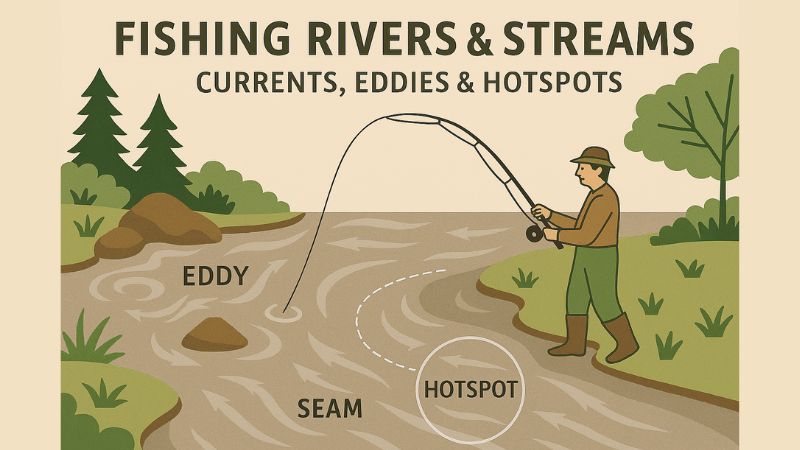Fishing Rivers and Streams: How to Read Currents, Eddies, and Hotspots for Better Catches
Fishing in moving water is more than tossing in a line and waiting. Rivers and streams are alive; they move, shift, and create natural patterns that decide where fish spend their time. If you understand those patterns, you can predict where fish will hide, feed, and rest.
Think of it like reading a book. The water tells a story, and each ripple, swirl, and shadow is a clue. In this guide, we’ll explore how to understand currents, eddies, and hotspots so your time on the water brings more success.
Understanding the Flow of a River
Why Currents Matter
The current is the engine of the river. It moves water, carries food, and shapes the environment. Fish are smart about conserving energy. They don’t fight against fast water all day; they position themselves where they can grab food drifting by without wasting strength.
The current’s speed, direction, and depth all affect where fish will be. If you learn to spot those small changes, you’ll unlock the river’s feeding zones.
The Different Parts of a River
Every river has unique features, but most share these key areas:
| Zone | Description | Why Fish Like It |
|---|---|---|
| Main Channel | Deepest and fastest part of the river | Brings a steady supply of food but can tire fish quickly |
| Riffles | Shallow areas with fast, choppy water | Oxygen-rich and great for insects — a buffet for fish |
| Pools | Deep, calm sections | Provide shelter and safe resting spots |
| Runs | Smooth water between riffles and pools | Steady flow that is easy to swim in |
Currents, Eddies, and Seams
Currents
The main flow is like a conveyor belt bringing food downstream. Fish often wait just to the side or below the fastest water, where they can dart in for food. If you cast slightly upstream, your lure or bait will drift naturally into their feeding lane.
Eddies
An eddy is where the water swirls backward, usually behind a boulder, bridge pillar, fallen tree, or sharp bend.
Eddies are goldmines for fishing because:
- They give fish a break from the main flow.
- Food collects in the swirling water.
- They attract both small fish and the larger predators that hunt them.
What is the best way to fish an eddy in a river?
Position yourself just upstream of the eddy and cast your bait or lure into the slower, swirling water. Let it drift naturally along the edge where the current slows. Fish often hold here to rest and grab food as it circles in.
Seams
A seam is the line where fast water meets slow water. Fish love this edge because they can sit in the calm section while watching the faster water for food. Working a lure right along this line can trigger quick strikes.
How do you spot fishing seams in streams?
Look for a visible line where fast, choppy water meets slower, smooth water. This “seam” often appears as a change in texture or slight color difference on the surface. Fish use seams as feeding lanes, staying in the calm side to watch for food drifting past.
Finding Hotspots in Rivers and Streams
Some areas almost always hold fish. These include:
- Behind or under large rocks
- Near overhanging trees or bushes (shade + insects)
- Around submerged logs or root systems
- Along sudden drops in the riverbed
- In the tail end of pools where water speeds up again
These are high-probability spots, so focus on them before covering less-structured water.
Techniques & Tactics for Productive Fishing
Choosing Gear for Moving Water
- Rod: Medium-light to medium strength for versatility
- Reel: Smooth drag system for sudden bursts from fish
- Line: Strong enough to handle rocks and snags (braided or abrasion-resistant mono)
Best Baits and Lures
- Live bait like worms, minnows, or crayfish
- Spinners for flash and vibration in faster water
- Soft plastics for finesse fishing in calm spots
- Crankbaits to mimic small fish in the current
Casting & Retrieval
- Upstream drift: Cast above your target and let the water carry your bait down.
- Across-stream sweep: Cast sideways and retrieve in an arc, covering more water.
- Downstream sneak: Let your bait move naturally from behind to surprise fish.
Drifting & Dead-Drifting
Let your bait move with the flow without pulling it too fast. Adjust weight so it stays just above the bottom, bouncing occasionally to mimic natural food.
River Fishing Strategies / Seasonal & Weather Considerations
Spring
Rivers run high and muddy from rain or snowmelt. Focus on calmer edges and flooded side channels.
Summer
Low water and higher temperatures push fish to shade, deep pools, or areas with strong oxygen flow.
Fall
Fish are aggressive and feeding heavily before winter. This is prime time for bigger catches.
Winter
Cold slows fish metabolism. Go deep, use slower retrieves, and focus on sunny parts of the river.
Safety and Good Fishing Habits in River Fishing
Wading Safety
- Use a sturdy wading staff
- Wear boots with strong grip
- Move slowly and face upstream for balance
Caring for Fish
If you release fish:
- Wet your hands before touching them
- Keep them in the water as much as possible
- Release quickly and gently
Respecting Regulations
Always check local laws and regulations on fishing seasons, size limits, and protected areas.
Quick River Fishing Cheat Sheet
| Feature | Why It’s Productive | Best Tactic |
|---|---|---|
| Currents | Delivers steady food supply | Cast slightly upstream into slow edges |
| Eddies | Shelter with food buildup | Drop bait into the swirl |
| Seams | Easy resting + feeding lane | Retrieve lure along the seam |
| Hotspots | Cover and ambush points | Use accurate, quiet casts |
Conclusion
Success in rivers and streams comes down to observation. Watch the water, read the patterns, and place your lure where fish have both food and safety. Once you start seeing the river like a map of energy and shelter, you’ll know exactly where to cast.
FAQs
1. How do you quickly tell where fish might be?
Look for areas where fast water meets slow water — these are natural feeding lanes.
2. What time of day is best for river fishing?
Early morning and late afternoon often bring the most active fish.
3. Should I fish the middle of the river?
Not always — fish often hold near edges, structures, and depth changes.
4. Is live bait always better?
Live bait can work well, but artificial lures can also be very effective when matched to conditions.
5. How do I avoid snags?
Keep your bait slightly above the bottom and avoid dragging it directly into heavy cover.
6. Can I fish eddies in winter?
Yes, but slow your presentation to match fish activity.
7. How deep should I fish in summer?
Target deeper pools or shaded runs where the water stays cooler.
8. What’s the biggest mistake anglers make?
Not paying attention to water speed and structure before casting.
9. Do fish move during storms?
Pressure changes can spark feeding, but safety should always come first.
10. How can I make my casts more accurate?
Practice short, controlled casts before trying long distances.

